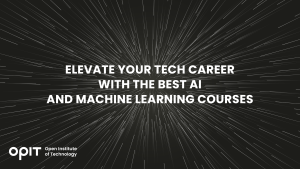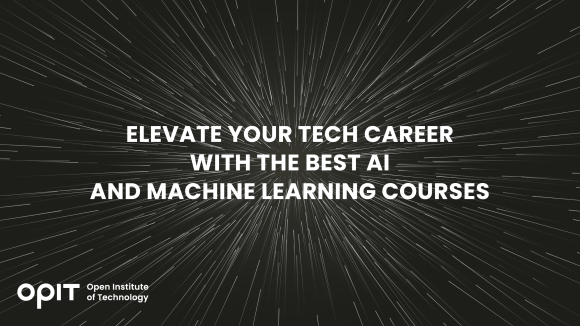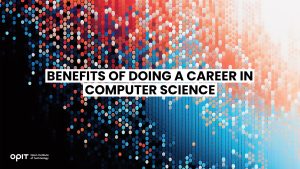

Artificial Intelligence (AI) and machine learning are two of the fastest-growing emerging technologies right now. In late 2022, generative AI burst onto the tech scene in the shape of ChatGPT and its antecedents. However, that’s not the first time AI has made a major impact. In fact, the first AI chatbot, Eliza, was around in the 1960s.
Both AI and machine learning do far more than chat and research. AI is embedded in analytics, predictive forecasting, and monitoring for multiple industries. As the use of AI and machine learning expands, the need for professionals with relevant skills is also growing exponentially.
OPIT (Open Institute of Technology) provides top-tier education in various tech fields, including highly respected machine learning and artificial intelligence courses. Let’s take a look at these fascinating technologies and how the right AI machine learning course can elevate your tech career.
Understanding AI and Machine Learning
When you’re searching for courses on artificial intelligence and machine learning, it helps to have a basic definition for both terms. If you already work in the tech industry, you likely work with one or both of these technologies every day. Yet they’re often so embedded within systems or apps that you might not even realize.
AI refers to the computer’s to exhibit behavior that replicates human thought patterns. However, the details of this definition are a little more complex than that. “Computers” can mean anything from a small subsystem to a supercomputer. It can also mean your smartphone or an app. And, by emulating human behavior, experts don’t necessarily mean AI does things exactly like us. Truly “thinking” AI with genuine cognitive abilities is a long way off.
What AI actually does is take things humans can already do – and do it faster and more often. Think about a software DevOps team requiring automated monitoring and testing of code prior to deployment. AI can do this while checking for vulnerabilities and producing relevant, actionable reports. In healthcare, AI uses pattern recognition to diagnose diseases quickly.
Machine learning is a subset of AI. It focuses on using algorithms to consistently and continuously improve pattern recognition for AI that appears to “learn.”
Courses in AI and machine learning are so popular because of the inherent usefulness of these technologies. Learning these skills now is a way to future-proof your tech career.
The Best AI and Machine Learning Courses
Numerous artificial intelligence and machine learning courses cover different topics and niches. You may choose to learn in a classroom setting or remotely. Some courses are short-term, generally covering foundational aspects of AI. Others carry on over several months for a deeper learning experience. Always consider how the course you invest in will impact your career advancement opportunities.
Absolute beginners may benefit from the Coursera IBM Applied Professional Certificate. This course runs entirely online over three months, presuming you can commit to 10 hours a week. Students learn the basics of AI, particularly how it powers IBM’s Watson AI services.
Oxford Online runs a 6-week online AI program course requiring 7-10 hours of commitment a week. This course looks at AI concepts and business cases for implementation and takes a glimpse at the future of AI.
For classroom-based courses on AI and machine learning, prospective students are best placed to contact local educational institutions. Offline courses vary in length, depth, and usefulness, so always check the syllabus and what certification you gain. It’s worth considering how far you’ll have to travel to gain a qualification.
One of the biggest challenges with AI is making it ethical. OPIT addresses that head-on with the MSc in Responsible AI. Learn advanced AI skills while keeping inclusivity and human interest at the heart of every aspect of the syllabus.
OPIT also offers other courses that consider the impact AI has on modern business practice. Undergraduates could consider the BSc in Digital Business, which includes a full Introduction to AI segment. There are also elective topics, including AI-Driven Software Development.
The Structure of AI and Machine Learning Courses
What should you expect from the best courses on AI and machine learning? Each course has a specific length, either in terms of study hours or a set deadline date. Most online courses have a specific intake date to make sure students get the right support at the right time.
Once you start your machine learning and AI course, you can expect a good balance between theory and practical application. For example, OPIT’s master’s degree course starts with foundational theory and critical thinking around ethics in AI. From here, students get to handle complex data sets. They program in Python and learn how to design effective AI-powered data pipelines.
The structure of your course will depend on the focus, but to give you the best foundation, courses may follow a similar pathway to this:
- Basics of AI, including the differences between AI and machine learning
- Discovering applications of AI — these may be general or industry-specific, depending on the nature of your course
- Data collation, analysis, and visualization
- Programming for AI
- Natural language processing (NLP) and natural language generation (NLG)
- Removing or preventing bias in AI training
Some courses will also offer advanced elective programs, such as understanding AI within the sphere of FinOps (financial operations) or business strategy. If you have a particular industry you’re hoping to excel in, look out for courses with topics that could help you further those ambitions.
Online AI and Machine Learning Courses: Flexibility and Accessibility
Choosing one of the best machine learning and AI courses to do online offers more benefits than new skills. Online learning allows you to study in your preferred environment and at your own pace. You just need to make sure you keep an eye on set deadlines.
You’re not distracted by a class full of people, but you still have access to tutors and support. Many open learning institutes have online communities of students. These are great for preventing isolation and gaining advice.
As a tech professional, the ability to set your own study schedule is essential. Online AI and machine learning courses provide flexibility, allowing you to learn as you work. With OPIT’s Master’s Degree in Responsible Artificial Intelligence, you could potentially have an MSc in 12-18 months without taking any time off work.
Key Skills Gained from AI and Machine Learning Courses
When choosing your online course on AI and machine learning, consider the skills you’ll learn. You should expect to cover:
- Data preprocessing
- Data cleansing
- Data visualization and storytelling
- Linear and nonlinear dimensionality reduction
- Manifold learning
- Human-centered AI design
- Language-agnostic AI programming skills
An MSc in AI and machine learning provides specialized skills and knowledge that you can use to address complex AI challenges in just about any industry.
Choosing the Right AI and Machine Learning Course for You
Picking the right AI and machine learning course is simpler when you consider your goals. Do you want a quick upskill and insight into emerging technologies? Or do you want an immersive course that empowers you to take on new career challenges? Most AI and machine learning courses will provide guidance on the type of career students could hope to pursue after completion.
Always look at the syllabus of a course and see if it meets your personal goals. If you’re unsure about any aspects, contact the education provider for more information.
OPIT’S MSc in Responsible Artificial Intelligence: An Overview
If you’ve decided an online AI and machine learning course is for you, as a graduate, an MSc is the natural choice. The next intake for the OPIT MSc in Responsible AI is September 2024, and details on how to apply are online.
What are the benefits of taking this course?
- A fast-track option to gain your master’s degree in just 12 months
- Fully inclusive fees — no hidden charges
- Various scholarship and funding options
- Availability of early-bird discounts
- Access to academic leaders from all over the world
- Education with an EU-accredited institution
Your MSc course covers every aspect of AI you might require for a career in AI and machine learning. Topics start with AI and ethics and quickly move into human-centered design, computer vision, and how AI impacts IoT and automation.
As you move into your final term, you start your MSc thesis, which focuses on AI projects with industrial relevance. There’s also the opportunity to pursue an internship to complement your thesis and gain vital experience.
AI and Machine Learning Courses for a Future-Proof Career
AI is now part of most growing industries, from property and real estate to healthcare and social care. Tech professionals have the opportunity to upskill themselves and move into fields that they have a real passion for. Organizations are looking for and willing to pay high salaries for knowledgeable, qualified AI experts.
Taking the time now to embark on machine learning and AI courses could speed your journey along your chosen career trajectory.
Related posts

Life is unpredictable. While many of us have specific hopes and expectations of how our futures will turn out, things don’t always go as expected. There are many variables and unexpected incidents that can interfere and force you to alter your plans, and this is particularly true when it comes to education.
For instance, you might have had plans to study a specific subject, but had to deviate from those plans due to unforeseen circumstances. Or you may have had to enter the workforce in an occupation different from the one you sought in an effort to earn an income, a move that may not provide you with the time or opportunity to achieve your desired educational aims.
In short, every individual’s career pathway is different, and very few go exactly as we expect from the outset. Fortunately, even if you experience a few false starts or sudden twists in your pathway, there are always options available to help you get back on track.
The Unpredictable Nature of Education
In theory, the educational process seems simple. You select a course of study that interests you from the vast array of subjects and prospective professions, select the appropriate classes, acquire the knowledge and skills you need to succeed, and then embark on your profession.
In reality, however, as many people know from firsthand experience, the road to education is often far from straightforward. Here are just some of the many challenges that can take your educational path in a completely different direction:
- Life’s Curveballs: As touched on in the introduction, life is impossible to predict. Financial hardships, health issues, and family emergencies are just some of the unfortunate occurrences that might derail even the most perfectly planned educational regime.
- Changing Interests: People’s desires and preferences don’t necessarily stay the same throughout their entire lives. As you grow, learn, and have new experiences, your interests may change, and so, too, may your educational objectives.
- Pressure and Burnout: Some academic paths are particularly challenging, demanding intense levels of study and hard work. This can sometimes prove too much to bear, even for the most resilient students.
- Failures and Setbacks: Conventional education largely builds around tests and examinations, requiring students to demonstrate their competencies repeatedly. It’s a system that doesn’t suit everyone, and test failures can lead to setbacks and delays.
- Inequality: People can be born with very different privileges and levels of access to education. Those in certain parts of the world may find it much more challenging to complete their education path for financial, cultural, or even political reasons.
- Late Bloomers: People develop at different paces. Some may struggle educationally early on in their lives, forcing them to make certain concessions or sacrifices related to their studies, only to find their feet later in life once they’ve entered the world of work.
Whether you’re a late bloomer, have had your educational aspirations delayed by personal problems, desire to learn new skills and try something different, or want to begin a fresh chapter in your professional life, the Open Institute of Technology (OPIT) may be able to help.
Introducing OPIT
OPIT is an online teaching platform, making high-level technological educational programs accessible to all, no matter their age or background. Offering education in fields like computer science, artificial intelligence, and digital business, OPIT provides a curated collection of degrees. In addition, they offer classes taught by world-leading tutors imparting the wisdom and skills students need to achieve their goals and become the tech leaders of tomorrow.
Meanwhile, for those who have had somewhat tumultuous or unpredictable educational paths, OPIT offers the perfect course corrector: the OPIT Foundation Year.
The OPIT Foundation Year
OPIT’s Foundation Year is a Pre-Tertiary Certificate in Information Technology, fully aligned with MQF/EQF Level 4 standards and valued at 60 ECTS credits. Lasting just one year, this program essentially serves as a comprehensive yet accessible springboard towards higher-level education, creating a path towards degrees and careers in dynamic, flexible fields, like computer science and digital business.
Like other OPIT programs, the Foundation Year is delivered entirely online via the OPIT Virtual Learning Environment. Combining live lectures, asynchronous content, and interactive assessments, students enjoy diverse and dynamic study experiences, acquiring core skills like academic writing, mathematics, and computer literacy, and building a bedrock of knowledge and confidence before taking their next steps.
Who Is the Foundation Program For?
The Foundation Program is designed to provide a solid base upon which to build the technological education many students need. It’s the perfect choice for those who are eager and ambitious to enter professions in AI, data science, and computing, but don’t feel that they have the necessary core skills and knowledge needed to dive straight into a degree.
Entry requirements are relatively relaxed in order to allow as many students as possible to enjoy the benefits of this program. With that said, applicants should ideally hold an MQF/EQF Level 3 or equivalent qualification, with the intention of pursuing a bachelor’s degree. A minimum of B2 level of English proficiency is also required, as this is the working and studying language of the institution.
What the Foundation Year Provides
Perhaps you’ve recently graduated, are considering a career change, or finally have the opportunity to return to education after initial delays or unexpected disruptions to your original plans. Either way, the Foundation Year can help you enjoy:
- Greater Self-Confidence: Foundation Year graduates gain the fundamental skills they need to enter degree programs with much more self-belief and assuredness.
- Superior Tech Knowledge: Lasting two terms, this course explores mathematics, academic reading and writing, and provides an introduction to computer hardware and software.
- Foundational Mathematics: Mathematics literacy forms a large part of the study focus for the Foundation Year, helping students feel more comfortable with numbers and formulas.
- Flexible Learning: Unlike more rigid, conventional education environments, OPIT gives you the freedom and flexibility to study at a pace that suits you best, all from the comfort of home.
- Global Community: OPIT is an international institution, with staff and students from all around the world eager to share knowledge, exchange ideas, and help one another.
Take Your Next Steps to Success With the OPIT Foundation Year
If you’re curious about a career in technology or have always wanted to work with AI, data, and computers, but struggled to find the time and opportunities you need to acquire relevant skills and knowledge, the Foundation Program was made for people like you.
It’s the ideal entry point into the exciting world of online education, and the perfect first step towards a prestigious degree from an innovative and increasingly successful institution. Download the brochure to learn more about it, or start your online application, today.

Students today have a broader range of fields of study to choose from than ever before, but with the world becoming increasingly technological and computers increasing in influence and importance, pursuing a career in computer science often proves a smart, strategic choice.
There are numerous benefits and career paths associated with studying and working in computer science, and we’ll be listing just a few of them in this guide.
High Average Salaries
With the rising cost of living in many parts of the world, it’s unsurprising that many students are thinking several decades ahead to determine what level of starting salaries they could obtain in different career fields.
Many are also seeking professions that offer the opportunity for growth and the ability to advance up the ranks over time, thus increasing their salary and their quality of life in the process.
If a strong, stable salary with the opportunity for improved income is one of your top career priorities, computer science should be at or near the top of your list of prospective careers.
According to recent data, computer scientists earn an average of over €65,000 per year, with certain jobs, like IT project leader and data scientist, paying ever higher. Starting salaries are strong, too, with graduates earning anywhere from €46,000 to €60,000, depending on their chosen profession and level of qualifications.
There are similarly high average salaries reported around the world in computer science and related fields such as data science and AI/ML engineering. These numbers are projected to increase in the years to come, pointing to computer science as a way for graduates to get off to the best financial start of any career.
Unrivaled Flexibility
A common problem with some subjects and courses is that they only provide graduates with a narrow set of skills and a similarly narrow range of potential professions to which they can apply those skills.
That’s not the case with computer science. Graduates in this field can enjoy instant access to a remarkably diverse array of career opportunities, with even newer opportunities being created all the time as technology evolves and innovations emerge.
A few of the many industries and roles you might choose to enter in the field of computer science include:
- Healthcare: As a software developer, data analyst, or cybersecurity expert
- Finance: As a fintech engineer, blockchain developer, or security analyst
- Media: As a graphics programmer, AI developer, or game developer
- Education: As an analyst, software developer, or machine learning engineer
Guaranteed Opportunities
Some career paths are more limited than others, with relatively low numbers of opportunities, recurring risks of job loss, or difficulty obtaining employment in the first place.
Again, with computer science, this simply isn’t the case. At a time when 75% of companies plan to embrace AI and other technologies by 2027, and businesses of all sizes and industries are now relying on computers more than ever before, computer science graduates can enjoy almost unbeatable job security.
Opportunities will continue to grow for people with good computing knowledge, whether that be in the obvious fields like software and web development, engineering, and AI development, or more niche sectors.
With so many options, you’re effectively guaranteed a long, rewarding career if you put in the necessary time and effort needed to establish a strong foundation of computing skills.
Rapidly Expanding and Evolving Industries
It’s no secret that the world of technology is a dynamic and fast-moving one. In the past 20 years alone, we’ve seen the proliferation of the internet, the rapid advancement of smartphones and wearable devices, the emergence of AI, and so much more.
In the years ahead, engineers and developers will continue to explore the boundaries of modern technology’s powers and potential, driving new innovations and improvements and opening more exciting job opportunities for those already established and experienced in this field.
Getting into computer science now could therefore provide a solid foundation for a career filled with excitement as you uncover and explore new ways of working with computers in fields as diverse as healthcare, finance, education, entertainment, manufacturing, logistics, and beyond.
Start Your Computer Science Career at OPIT
We’ve discussed some of the many benefits associated with careers in computer science, from the high starting salaries to the rapidly growing array of job options available to graduates. By now, you may be eager to follow this particular career path and take advantage of the wealth of opportunities.
If you’re wondering how to start, the Open Institute of Technology (OPIT) may hold the answers you need. As an exclusively online learning platform, specializing in computer science and digital business, and staffed by some of the world’s leading tech experts, OPIT is producing the tech leaders of tomorrow.
Some of the many advantages of learning with OPIT include:
- Accessible and flexible online education that matches your learning style and schedule
- Heavy focus on real-world applications of the skills you acquire
- An international community of like-minded students from around the globe
- A top team of tutors and lecturers from varying fields and industries
- Progressive assessment of skills and understanding – not constant exams
OPIT offers a small, curated selection of courses for those seeking to gain the technological skills and knowledge to succeed in their chosen areas of expertise. That includes a BSc (Hons) in Computer Science – a six-term program, worth 180 ECTS credits.
Numerous IT industry leaders and experts helped develop this fully accredited undergraduate degree, which is online and accessible to all. Like other OPIT courses, it offers a flexible learning program, with progressive assessments, fast-track options, and the opportunity to be part of a growing community of learners and tutors.
If the benefits of doing a career in computer science interest you, download the OPIT BSc in Computer Science brochure or fill out an online application today and take your first step toward a rewarding and fulfilling profession.
Have questions?
Visit our FAQ page or get in touch with us!
Write us at +39 335 576 0263
Get in touch at hello@opit.com
Talk to one of our Study Advisors
We are international
We can speak in:


